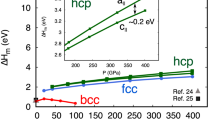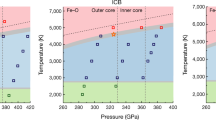Abstract
Soon after the discovery of seismic anisotropy in the Earth's inner core1, it was suggested that crystal alignment attained during deformation might be responsible2. Since then, several other mechanisms have been proposed to account for the observed anisotropy3,4, but the lack of deformation experiments performed at the extreme pressure conditions corresponding to the solid inner core has limited our ability to determine which deformation mechanism applies to this region of the Earth5. Here we determine directly the elastic and plastic deformation mechanism of iron at pressures of the Earth's core, from synchrotron X-ray diffraction measurements of iron, under imposed axial stress, in diamond-anvil cells. The ε-iron (hexagonally close packed) crystals display strong preferred orientation, with c-axes parallel to the axis of the diamond-anvil cell. Polycrystal plasticity theory predicts an alignment of c-axes parallel to the compression direction as a result of basal slip, if basal slip is either the primary or a secondary slip system. The experiments provide direct observations of deformation mechanisms that occur in the Earth's inner core, and introduce a method for investigating, within the laboratory, the rheology of materials at extreme pressures.
This is a preview of subscription content, access via your institution
Access options
Subscribe to this journal
Receive 51 print issues and online access
$199.00 per year
only $3.90 per issue
Buy this article
- Purchase on Springer Link
- Instant access to full article PDF
Prices may be subject to local taxes which are calculated during checkout




Similar content being viewed by others
References
Morelli, A., Dziewonski, A. M. & Woodhouse, J. H. Anisotropy of the core inferred from PKIKP travel times. Geophys. Res. Lett. 13, 1545– 1548 (1986).
Jeanloz, R. & Wenk, H.-R. Convection and anisotropy of the inner core. Geophys. Res. Lett. 15, 72– 75 (1988).
Jeanloz, R. The nature of the Earth's core. Ann. Rev. Earth Planet. Sci. 18, 357–386 (1990).
Stixrude, L. & Brown, J. M. in Ultrahigh-Pressure Mineralogy: Physics and Chemistry of the Earth's Deep Interior (ed. Hemley, R. J. ) 261–282 (Reviews in Mineralogy, Vol. 37, Mineralogical Society of America, Washington DC, 1998).
Poirier, J. -P. & Price, G. D. Primary slip system of ε-iron and anisotropy of the Earth's inner core. Phys. Earth Planet. Inter. 110, 147– 156 (1999).
Soderlind, P., Moriarty, J. A. & Wills, J. M. First principles theory of iron up to earth-core pressures: structural, vibrational, and elastic properties. Phys. Rev. B 53, 14063–14072 ( 1996).
Stixrude, L. & Cohen, R. E. High-pressure elasticity of iron and anisotropy of Earth's inner core. Science 267, 1972–1975 (1995).
Saxena, S. et al. Synchrotron x-ray study of iron at high pressure and temperature. Science 269, 1703–1704 (1995).
Yoo, C. S., Akella, J., Campbell, A. J., Mao, H. K. & Hemley, R. J. Phase diagram of iron by in situ x-ray diffraction: implications for Earth's core. Science 270, 1473–1475 (1995).
Andrault, D., Fiquet, G., Kunz, M., Visocekas, F. & Hausermann, D. The orthorhombic structure of iron: an in-situ study at high temperature and high pressure. Science 278, 831–834 (1997).
Shen, G. & Heinz, D. L. in Ultrahigh-Pressure Mineralogy: Physics and Chemistry of the Earth's Deep Interior (ed. Hemley, R. J.) 369–396 (Reviews in Mineralogy, Vol. 37, Mineralogical Society of America, Washington DC, 1998).
Hemley, R. J. et al. X-ray imaging of stress and strain of diamond, iron, and tungsten at megabar pressures. Science 276, 1242– 1245 (1997).
Singh, A. K., Mao, H. K., Shu, J. & Hemley, R. J. Estimation of single-crystal elastic moduli from polycrystalline x-ray diffraction at high pressure: application to FeO and iron. Phys. Rev. Lett. 80, 2157–2160 (1998).
Mao, H. K. et al. Elasticity and rheology of iron above 220 GPa and the nature of the Earth's inner core. Nature 396, 741 –743 (1998).
Wenk, H.-R., Matthies, S., Donovan, J. & Chateigner, D. BEARTEX, a Windows-based program system for quantitative texture analysis. J. Appl. Crystallogr. 31, 262–269 (1998).
Kocks, U. F., Tomé, C. N. & Wenk, H.-R. Preferred Orientations in Polycrystals and Their Effect on Materials Properties (Cambridge Univ. Press, 1998).
Mao, H. K., Wu, Y., Chen, L. C., Shu, J. F. & Jephcoat, A. P. Static compression of iron to 300 GPa and Fe 0.8Ni0.2 alloy to 260 GPa: Implications for composition of the core. J. Geophys. Res. 95, 21737– 21742 (1990)
Akhtar, A. Basal slip in zirconium. Acta Metall. 21, 1–11 (1973).
Greenspan, J. in Beryllium, its Metallurgy and Properties (ed. Hausner, H. H.) 240–246 (University of California Press, Berkeley, 1965).
Tenckhoff, E. The development of the deformation texture in zirconium during rolling in sequential passes. Metall. Trans. A 9, 1401 –1412 (1978).
Prantil, V. C., Jenkins, J. T. & Dawson, P. R. Modeling deformation induced textures in titanium, using analytical solutions for constrained single crystal response. J. Mech. Phys. Solids 43, 1283–1302 (1995).
Lebensohn, R. A. & Tomé, C. N. A self-consistent anisotropic approach for the simulation of plastic deformation and texture development of polycrystals – Application to zirconium alloys. Acta Metall. Mater. 41, 2611–2624 (1993).
Romanowicz, B., Li, X. D. & Durek, J. Anisotropy of the inner core: Could it be due to low-order convection? Science 274, 963– 966 (1996).
Shearer, P. M. Constraints on inner core anisotropy from PKP(DF) travel times. J. Geophys. Res. 99, 19647–19659 (1994).
Song, X. Anisotropy of the Earth's inner core. Rev. Geophys. 35, 297–313 (1997).
Su, W. -J. & Dziewonski, A. M. Inner core anisotropy in three dimensions. J. Geophys. Res. 100, 9831– 9852 (1995).
Hauk V. & Kockelmann, H. Evaluation of single crystal elastic constants from mechanical and X-ray elastic constants of the polycrystal. Z. Metall. 70, 500–502 (1979).
Bittorf, Ch., Matthies, S., Priesmeyer, H. G. & Wagner, R. Diffractive determination of thermo-elastic single crystal constants using polycrystalline samples. Intermetallics 7, 1–8 (1998).
Wenk, H. -R., Baumgardner, J. R., Lebensohn, R. A. & Tomé, C. N. A convection model to explain anisotropy of the inner core. J. Geophys. Res. 105, 5663–5677 (2000).
Karato, S. Seismic anisotropy of the Earth's inner core caused by the Maxwell stress-induced flow. Nature 402, 871–873 (1999).
Acknowledgements
We thank A. K. Singh, S. Merkel and J. Hu for discussions and assistance. The work was supported by IGPP-LANL and NSF.
Author information
Authors and Affiliations
Corresponding author
Rights and permissions
About this article
Cite this article
Wenk, HR., Matthies, S., Hemley, R. et al. The plastic deformation of iron at pressures of the Earth's inner core . Nature 405, 1044–1047 (2000). https://doi.org/10.1038/35016558
Received:
Accepted:
Issue Date:
DOI: https://doi.org/10.1038/35016558
This article is cited by
-
Tensorial stress-plastic strain fields in α - ω Zr mixture, transformation kinetics, and friction in diamond-anvil cell
Nature Communications (2023)
-
Electrical and thermal conductivity of Earth’s core and its thermal evolution—A review
Acta Geochimica (2022)
-
Atomistic simulation of martensitic transformations induced by deformation of α-Fe single crystal during the mode-I fracture
Journal of Materials Science (2021)
-
Tensorial stress−strain fields and large elastoplasticity as well as friction in diamond anvil cell up to 400 GPa
npj Computational Materials (2019)
-
The activation of 〈c + a〉 non-basal slip in Magnesium alloys
Journal of Materials Science (2012)
Comments
By submitting a comment you agree to abide by our Terms and Community Guidelines. If you find something abusive or that does not comply with our terms or guidelines please flag it as inappropriate.



